|
|
| Sei in: Cinema e Medioevo ® Vampiria. Tutti i film sui vampiri ® I film in ordine alfabetico (1896-oggi) |

Papà, Padre Rana è morto
(Papa, umer ded moroz)
1991, regia di Yevgeni Ufit

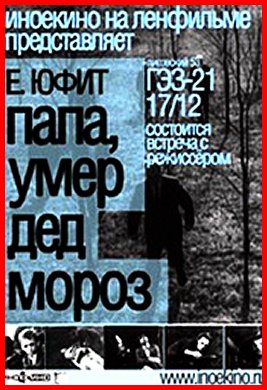
Scheda: Nazione: Russia - Produzione: Lenfilm Studio, The Experimental Studio of the First Film - Distribuzione: Svobodny Polet Rekords Ltd., Drugaya Kul'tura - Soggetto: dal racconto La famiglia del Vurdalak (1843), di Aleksej Tolstoj - Sceneggiatura: Vladimir Maslov - Fotografia: Alexy Burov - Formato: B.N., film sperimentale - Durata: 81'.
Cast:
Ivan Gangja, Liudmila Kozlovskaya, Anatoly Egorov, Valery Krishtanenko.
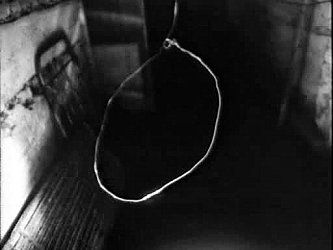
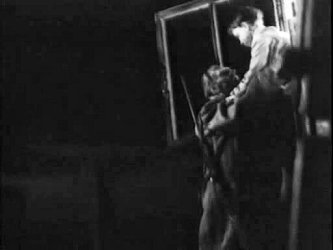


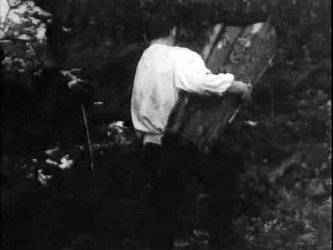

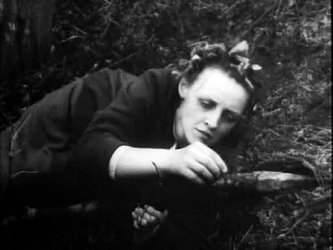
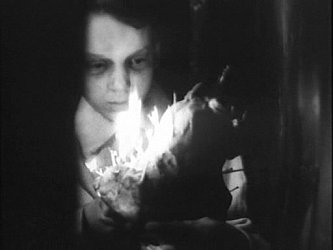
![]() Trama e commenti:
filmtv.it -
forum.nocturno.it
-
freddeluciparlano.blogspot.it
-
davinotti.com -
vistierivisti.wordpress.com: «Tratto
da un racconto di Tolstoj, Papà, Padre Rana è morto è il primo film della
corrente che Yufit ha definito “necrorealismo”. La storia è quella di un
biologo, ossessionato da un’opera che sta scrivendo su una nuova specie di
faina, che, in campagna dal cugino per un paio di giorni, assiste ad una serie
di inquietanti fenomeni: da un gruppo di uomini vestiti di nero che girano per
la città seviziando chiunque capiti loro a tiro, dalle stranezze e le debolezze
della sua stessa famiglia, al suicidio di due bambini. Nel frattempo, un uomo
cieco ed un bambino malaticcio tendono trappole mortali ad innocenti vittime in
un labirinto sotterraneo. Decisamente un film particolare, quello di Yufit, di
difficile interpretazione. Talmente lontano dalla sensibilità occidentale da
risultare a tratti incomprensibile, Papà, Padre Rana è morto è un ritratto
inquietante e orrorifico della vita umana e della sua insensatezza. Una poesia
oscura infarcita di simbolismi e metafore, il film presenta una trama più che
frammentaria, a volte incoerente, altre del tutto inesistente. Come su un
palcoscenico oscuro, nella vicenda del biologo senza nome si muovono personaggi
senza speranza, che a malapena aprono bocca, risucchiati nel vortice delle loro
esistenze vuote. Manca in Yufit lo spiritualismo di Tarkovski e degli altri
registi russi che lo hanno preceduto, ma tolto questo, non resta altro che un
enorme vuoto, un buco nero che assorbe ogni cosa, non solo la voglia di vivere
dei personaggi, ma la vita stessa. Inutile cercare un senso a molte delle scene
e delle battute del film: spesso non c’è proprio, o comunque non viene
volontariamente rivelato. Il Padre Rana del titolo è il Babbo Natale russo, come
a dire: il tempo delle favole è finito, il tempo dell’innocenza è finito, è
l’ora di prendere atto dell’assoluta insensatezza della nostra esistenza. Un
film difficile, angosciante, insensato, che vuole essere specchio nientedimeno
che della vita stessa. Se poi riesca o meno nel suo obiettivo, spetta al
giudizio dei singoli spettatori».
Trama e commenti:
filmtv.it -
forum.nocturno.it
-
freddeluciparlano.blogspot.it
-
davinotti.com -
vistierivisti.wordpress.com: «Tratto
da un racconto di Tolstoj, Papà, Padre Rana è morto è il primo film della
corrente che Yufit ha definito “necrorealismo”. La storia è quella di un
biologo, ossessionato da un’opera che sta scrivendo su una nuova specie di
faina, che, in campagna dal cugino per un paio di giorni, assiste ad una serie
di inquietanti fenomeni: da un gruppo di uomini vestiti di nero che girano per
la città seviziando chiunque capiti loro a tiro, dalle stranezze e le debolezze
della sua stessa famiglia, al suicidio di due bambini. Nel frattempo, un uomo
cieco ed un bambino malaticcio tendono trappole mortali ad innocenti vittime in
un labirinto sotterraneo. Decisamente un film particolare, quello di Yufit, di
difficile interpretazione. Talmente lontano dalla sensibilità occidentale da
risultare a tratti incomprensibile, Papà, Padre Rana è morto è un ritratto
inquietante e orrorifico della vita umana e della sua insensatezza. Una poesia
oscura infarcita di simbolismi e metafore, il film presenta una trama più che
frammentaria, a volte incoerente, altre del tutto inesistente. Come su un
palcoscenico oscuro, nella vicenda del biologo senza nome si muovono personaggi
senza speranza, che a malapena aprono bocca, risucchiati nel vortice delle loro
esistenze vuote. Manca in Yufit lo spiritualismo di Tarkovski e degli altri
registi russi che lo hanno preceduto, ma tolto questo, non resta altro che un
enorme vuoto, un buco nero che assorbe ogni cosa, non solo la voglia di vivere
dei personaggi, ma la vita stessa. Inutile cercare un senso a molte delle scene
e delle battute del film: spesso non c’è proprio, o comunque non viene
volontariamente rivelato. Il Padre Rana del titolo è il Babbo Natale russo, come
a dire: il tempo delle favole è finito, il tempo dell’innocenza è finito, è
l’ora di prendere atto dell’assoluta insensatezza della nostra esistenza. Un
film difficile, angosciante, insensato, che vuole essere specchio nientedimeno
che della vita stessa. Se poi riesca o meno nel suo obiettivo, spetta al
giudizio dei singoli spettatori».
![]() Plot Summary, Synopsis, Review:
IMDb -
allmovie.com
-
nytimes.com
-
emanuellevy.com
-
rottentomatoes.com
-
thelastexit.net
-
cinema.nl
-
explore.bfi.org.uk
-
taliesinttlg.blogspot.co.uk:
«Family of
the Vourdalak (1843) by Count Alexis Tolstoy is a classic 19th Century
vampire tale. Most famously it was made into one of three short films in Mario
Bava’s anthology
Black Sabbath
and was the source for the film
Night of the Devils.
Both were blooming marvellous films but neither could prepare you for the
surreal Papa, umer ded moroz. That isn’t to say that the film is a bad film, it
certainly isn’t. But it is most definitely strange. Tolstoy’s story is
recognisable in the film and the vampiric elements are hiding in plain sight. If
you dislike arthouse films then you are probably better looking away now.
However the film has a way of catching a hold of you and drawing you into its
eerie landscape – made all the more sparse for the lack of musical score. It
begins with a man underground – possibly in a sewer or water logged bunker. He
trips and falls head first into a wire noose, the trap killing him. A young boy
with dead eyes and a one legged man go to him. His watch is stolen, his suitcase
emptied of the metalwork contents and filled with the clothes stripped from his
body. His naked corpse is wheeled away on a trolley and disposed of in fast
flowing waters. The trap, it is clear, was constructed by this pair. A biologist
is investigating a rodent, a shrew-mouse he says. He plans to stay with his
cousin in the countryside whilst working on his paper about the mouse and so
takes a train out to the country. As they travel, the passenger next to him
peaks around a curtain and announces, “Forest” and then “Lake”. When the
biologist disembarks he sees a group of men in black suits, stood in a field,
crowded around what is clearly a body. They finish wrapping and leave. The
biologist approaches and removes some of the shroud bindings. It is a woman,
still alive.
Plot Summary, Synopsis, Review:
IMDb -
allmovie.com
-
nytimes.com
-
emanuellevy.com
-
rottentomatoes.com
-
thelastexit.net
-
cinema.nl
-
explore.bfi.org.uk
-
taliesinttlg.blogspot.co.uk:
«Family of
the Vourdalak (1843) by Count Alexis Tolstoy is a classic 19th Century
vampire tale. Most famously it was made into one of three short films in Mario
Bava’s anthology
Black Sabbath
and was the source for the film
Night of the Devils.
Both were blooming marvellous films but neither could prepare you for the
surreal Papa, umer ded moroz. That isn’t to say that the film is a bad film, it
certainly isn’t. But it is most definitely strange. Tolstoy’s story is
recognisable in the film and the vampiric elements are hiding in plain sight. If
you dislike arthouse films then you are probably better looking away now.
However the film has a way of catching a hold of you and drawing you into its
eerie landscape – made all the more sparse for the lack of musical score. It
begins with a man underground – possibly in a sewer or water logged bunker. He
trips and falls head first into a wire noose, the trap killing him. A young boy
with dead eyes and a one legged man go to him. His watch is stolen, his suitcase
emptied of the metalwork contents and filled with the clothes stripped from his
body. His naked corpse is wheeled away on a trolley and disposed of in fast
flowing waters. The trap, it is clear, was constructed by this pair. A biologist
is investigating a rodent, a shrew-mouse he says. He plans to stay with his
cousin in the countryside whilst working on his paper about the mouse and so
takes a train out to the country. As they travel, the passenger next to him
peaks around a curtain and announces, “Forest” and then “Lake”. When the
biologist disembarks he sees a group of men in black suits, stood in a field,
crowded around what is clearly a body. They finish wrapping and leave. The
biologist approaches and removes some of the shroud bindings. It is a woman,
still alive.
Having helped her he goes to his cousin’s house. A woman (his cousin's wife) lets him in and his cousin, on hearing of their familial bond, hugs him fiercely and then sits with him in silence. The wife returns and also sits in silence. Their young son eventually makes an appearance. The film deliberately sits with them, the silence pregnant, the dialogue sparse throughout the film, and yet somehow you are pulled into this sordid, dirty world with peeling wallpaper and muddy clothes. A man enters the house, the boy calls him grandfather and we recognise this from Tolstoy. The biologist later sees the old man and the boy outside and, later still, clears grasses away to find the boy left languid and deathlike, softly imploring his grandfather to bestow more kisses. Later we see the father with an axe, sharpening a long trunk of wood into a stake. When the mother deliberately throws it into the river the father is angered and inconsolable – the son, of course, has died and the stake is lost, while the dreamlike quality of the film means that the idea of simply sharpening another stake is not appropriate. With strange rituals from the men in the fields, homosexual lust hidden behind a closed door, an existential dentist who stuffs the mouth with cotton and a child’s suicide; this film guides us along rare paths. The film, to some degree, reminded me of Vampyr in timbre and in that the actors seemed chosen for their faces as much as anything, and I wouldn’t be surprised to hear that they were chosen because the director felt they looked the part. Yet the film achieves an hallucinatory cohesiveness because of this. This works so well because it is a dreamscape (or should that be a nightmare), because it might be purgatory or worse, because it refuses to explain but forces speculation and because it is undoubtedly Tolstoy’s story. The Grandpa is most definitely a vourdalak, his grandson the first victim. Of course, there is also the joy of being able to post about a film called Daddy, Santa Claus is Dead. 7 out of 10, with the health warning that it is arthouse, with all the entail».
Conosciuto anche con i titoli: Daddy, Santa Claus is Dead; Daddy, Father Frost Is Dead; Father, Santa Klaus Has Died.